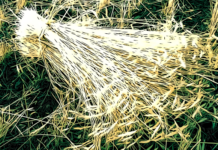Food consumption in Italy is converging on the search for healthy foods, so-called
superfoods
, and of foods as closely related to territories and traditions as possible. Not only that
PDO
e
PGI
, but also historical crops such as ancient grains
, to which this analysis is devoted.
Ancient grains vs. modern grains
Ancient grains-pending an agreed agronomic or legal definition-are understood to be dynamic wheat populations with historical origin, distinct identity, and absence of genetic improvement through inbreeding. Mostly these are locally adapted plants with the help of traditional farming systems (which also still lack unambiguous definition), characterized by taller size and less tenacious gluten than modern varieties.
A lively scientific debate that has been going on for some years contrasts the properties of ancient versus modern grains. The dispute tends to be focused on the nutritional properties of the various genotypes alone, neglecting the characteristics of the finished products in relation to the different processes. Therefore, it is proposed to extend the analysis to agronomic and technological aspects including, among others, the stages of milling, dough rising, and pasta-making techniques.
Gluten and wheat in the diet
The role of wheat and its proteins
in the diet is widely debated, partly because of economic interests
opposed. So the promoters of diets gluten-free accuse modern grains of being ‘chronic poisons‘ (Davis 2011) and the great producers of commodities reply that ‘wheat gluten is not bad for you‘ (National Association of Wheat Growers, 2013).
Gluten in ‘ancient grains’ does not differ quantitatively from modern varieties. What is different, however, is thegluten index, a parameter that expresses strength and is much lower in history wheat, the processing of which is therefore more difficult and not compatible with modern pasta-making technologies.
Gluten proteins from ancient wheat varieties also contain fewer ‘toxic epitopes,’ the amino acid sequences recognized by the lymphocytes of celiac subjects (Van den Broeck et al., 2010). A diet of wheat varieties with fewer ‘toxic epitopes’ could therefore help the prevention of celiac disease, in view of several factors associated with its occurrence (Ventura et al., 1999; Ivarsson et al., 2000; Fasano, 2006).
Comparative studies between wheat varieties
ancient and modern have since shown that the former produce grain that lowers or cancels the production of pro-inflammatory cytokines in the human body (Gallo et al., 2010; Di Silvestro et al., 2012; Valerii et al., 2014).
Ancient grains and health
Significant differences between ancient and modern grains were found on micronutrients (vitamins and minerals) and other compounds from the plant’s secondary metabolism (‘functional’ or ‘bioactive’ compounds). In terms of quantity and quality, as well as variety of compounds (Dinelliet al., 2007).
Several studies actually show a progressive decrease in mineral contents, in wheat caryopses, over the past 160 years. Highly productive low-cut cultivars, in particular, are found to have lower copper, iron, zinc and magnesium contents (Fan et al., 2008; Ficco et al., 2009; Zhao et al., 2009).
Flours made from ancient grains
are also characterized by a higher content and variety of biologically active phytochemicals such as polyphenols (flavonoids, lignans, isoflavones), carotenoids, tocopherols, and fiber
. To which are attributed important functions of
nutraceutical
, including antitumor, anti-inflammatory, immunosuppressive, cardiovascular, antioxidant, and antiviral activities (Dinelli et al., 2007).
A recent study found that the use of ancient grain flours causes significant lowering of both total and LDL (or ‘bad’) cholesterol and blood glucose on the one hand. On the other hand, we find an increase in circulating stem cells, mobilized from the bone marrow, which are able to repair damaged blood vessels (Sereni et al., 2016).
Finally, ‘convincing’ beneficial effects affect various parameters related to cardio-metabolic diseases, such as lipid profiles, glycemic profiles, and inflammatory and oxidative status (Dinu et al., 2017).
TABLE – WHEAT COMPONENTS RESPONSIBLE FOR SOME DISEASES
To promote the preservation of beneficial substances, flour from ‘integrain‘ milling should be used in the diet. So as to preserve the embryo and the outer layers of the grain that are rich in fiber, minerals and bioactive compounds.
Ancient grains, the transformation processes
The study of the properties of ancient grains deserves a broader evaluation that also takes into account environmental factors and transformation processes.
Ancient grains are devoted to processing techniques that respect the need to maintain nutritional characteristics, such as whole grain milling, which is a typical feature of stone mills.
Theleavening processes-with particular regard to the nature of the yeasts used and the timing of leavening-in turn affect the quality of the final product. Brewer’s yeast, in particular, leads to rapid fermentation and high CO2 production. Conversely, the use of so-called ‘sourdough’ generally allows for baked goods characterized by greater digestibility and less anti-nutritional substances. With positive effects on gut microflora, supply of substances that prevent degenerative diseases and improved gluten quality (Di Cagno et al., 2008).
The longer leavening time (> 4 hours) also allows for a reduction in some short-chain carbohydrates, the so-called FODMAPs( Fermentable Oligo Di andMono-saccharides and Polyols). Contributing to the control of Irritable Bowel Syndrome (IBS) symptoms and other functional gastrointestinal disorders (Ziegler et al., 2016).
Drying temperatures, in the dry pasta production process, deserve equal consideration. ‘Industrial’ pastas are usually dried at high temperatures (> 90°C), well beyond the 40-45°C of tradition. High-temperature drying of pasta drastically reduces its nutritional value, as it destroys thermolabile vitamins and decreases the amount of an essential amino acid-lysine-by up to 50 percent. In addition to resulting in the formation of furosin, which attacks intestinal villi, altering their structural and functional integrity.
Paolo Caruso, Paolo Guarnaccia* and Dario Dongo
(*) Paolo Guarnaccia is a professor of Agronomy and Herbaceous Crops at the Department of Agriculture, Food and Environment, University of Catania, Italy.
Bibliography
Davis W.R., 2011, Wheat Belly: Lose the Wheat, Lose the Weight, and Find Your Path Back to Health. Rodale Books.
Di Cagno R., Rizzello C. G., De Angelis M., Cassone A., GiulianiG., Benedusi A., Limitone A., Surico R. F., Gobbetti M. 2008.Use of Selected Sourdough Strains of Lactobacillus for Removing Gluten and Enhancing the Nutritional Properties of Gluten-Free Bread. Journal of Food Protection, Vol. 71, No. 7, 2008, Pages 1491-1495.
Di Silvestro R., Marotti I., Bosi S., Bregola V., Carretero A., SedejI., Mandic A., Sakac M., Benedettelli S., Dinelli G. Health-promoting phytochemicals of Italian common wheat varieties grown under low-input agricultural management. – J Sci Food Agric. 2012 Nov;92(14):2800-10. doi: 10.1002/jsfa.5590. Epub2012 Jan 25.
Dinelli G., Marotti I., Bosi S., Benedettelli S., Ghiselli L., Cortacero-Ramirez S., Carrasco- Pancorbo A., Segura-CarreteroA., Fernandez-Gutierrez A., 2007. Lignan profile in seeds of modern and old Italian soft wheat (Triticum aestivum L.) cultivars as revealed by CE-MS analyses). Electrophoresis. 2007 Nov;28(22):4212-9.
Dinu M., Whittaker A., Pagliai G., Benedettelli S., Sofi F. (2017). Ancient wheat species and human health: biochemical and clinical implications. The Journal of Nutritional Biochemistry. 52:1-9 – January 2018.
Fan M.S., Zhao F.J., Fairweather-Tait S.J., Poulton P.R., Dunham S.J., McGrath S.P., 2008. Evidence of decreasing mineral density in wheat grain over the last 160 years. Journal of Trace Elements in Medicine and Biology, 22:315-324.
Fasano A. (2006) Systemic autoimmune disorders in celiac disease. Curr Opin Gastroenterol 22:674-679 CrossRefPubMed.
Ficco D.B.M., Riefolo C., Nicastro G., De Simone V., Di Gesù A.M., Beleggia R., Platani C., Cattivelli L., De Vita P., 2009. Phytate and mineral elements concentration in a collection of Italian durum wheat cultivars. Field Crops Research, 111:235- 242.
Gallo G., Lo Bianco M., Bognanni R., Saimbene G., Orlando A., Grillo O., Saccone R. and Venora G. 2010 – Durum Wheat Bread: Old Sicilian Varieties and Improved Ones – Aug. 2010, Volume 4, No.4 (Serial No.29) – Journal of Agricultural Science and Technology, ISSN 1939-1250, USA.
Ivarsson A., Persson L.A., Nystrom L., Ascher H., Cavell B., Danielsson L., Dannaeus A., Lindberg T., Lindquist B., Stenhammar L., Hernell O., 2000. Epidemic of coeliac disease in Swedish children. Acta Paediatr 89:165-171CrossRefPubMed.
Kissing Kucek L., Veenstra L. D., AmnuaycheewaP., SorrellsM.E, 2015. A Grounded Guide to Gluten: How Modern Genotypes and Processing Impact Wheat Sensitivity. Inst. Food Technol. doi: 10.1111/1541-4337.12129
Rubio-Tapia A., Kyle R.A., Kaplan E.L., Johnson D.R., Page W.,2009. Increased prevalence and mortality in undiagnosed celiac disease. Gastroenterology 137:88-93.
Sereni A., Cesari F., Gori A.M., Maggini N., Marcucci R., Casini A., 2016. Cardiovascular benefits from ancient grain bread consumption: findings from a double-blinded randomized crossover intervention trial. International Journal of Food Sciences and Nutrition. Page 1-7.
Valerii M.C., Ricci C., Spisni E., Di Silvestro R., De Fazio L., Cavazza E., Lanzini A., Campieri M., Dalpiaz A., Pavan B., Volta U. and Dinelli G., 2008. Responses of peripheral blood mononucleated cells from non-celiac gluten sensitive patients to various cereal sources – Food Chemistry 176 (2015) 167-174
Van den Broeck H. C., De Jong H., C.Elma M. J. Salentijn E. M. J.,- Dekking L.,-Bosch D.,-Hamer R. J.,- Gilissen L. J. W. J, van der Meer I. M. Smulders M J. M., 2010. Presence of celiac disease epitopes in modern and old hexaploid wheat varieties: wheat breeding may have contributed to increased prevalence of celiac disease. Theor Appl Genet (2010) 121:1527-1539 DOI 10.1007/s00122-010-1408-4).
Ventura A., Magazzù G., Greco L., 1999. Duration of exposure to gluten and risk for autoimmune disorders in patients with celiac disease. Gastroenterology 117:297-303 CrossRefPubMed.
Zhao F.J., Su Y.H., Dunham S.J., Rakszegi M., Bedo Z., McGrath S.P., Shewry P.R., 2009. Variation in mineral micronutrient concentrations in grain of wheat lines of diverse origin. Journal of Cereal Science, 49:290-295.
Ziegler J.U., Steiner D., Friedrich C., Longin H., Würschum T., SchweiggertR.M., Carle R., 2016. Wheat and the irritable bowel syndrome – FODMAP levels of modern and ancient species and their retention during bread making. Journal of Functional Foods25 ( 2016 ) 257-266.











